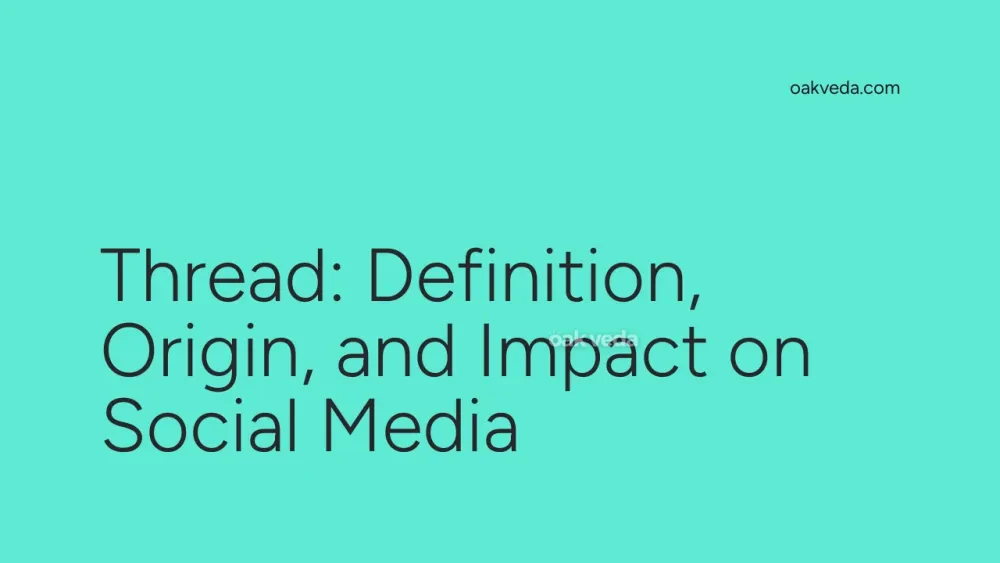
What is a Thread?
A thread on social media is a series of connected posts or comments that form a cohesive conversation or discussion around a specific topic. Threads typically begin with an initial post and are followed by subsequent replies, creating a chain of related content. This format allows users to engage in more in-depth discussions, share information, and follow conversations more easily.
Origin and Development of Threads
The concept of threads originated in early online forums and message boards, where users could reply to specific posts, creating a hierarchical structure of conversations. As social media platforms evolved, they adopted and adapted this format to suit their unique interfaces and user experiences.
Twitter popularized the modern concept of threads in 2017 when it increased its character limit from 140 to 280 and introduced a dedicated thread feature. This allowed users to connect multiple tweets seamlessly, making it easier to share longer stories or complex ideas.
How Threads Work
Threads work by linking multiple posts or comments together in a logical sequence. Here's how they typically function:
- Initial Post: A user creates the first post in the thread, introducing the topic or starting the conversation.
- Replies: Other users can respond directly to the initial post or to subsequent replies.
- Branching: Threads can branch off into sub-discussions, creating a tree-like structure of conversations.
- Visibility: Most platforms offer ways to expand or collapse threads, making it easier to navigate long conversations.
- Notifications: Users involved in a thread often receive notifications when new replies are added, encouraging ongoing engagement.
Popular Examples of Threads
Threads are widely used across various social media platforms:
- Twitter Threads: Users can create threads by replying to their own tweets, often used for storytelling, tutorials, or breaking news updates.
- Reddit Comment Threads: Discussions branch out into nested comment threads, allowing for in-depth conversations on specific points.
- Facebook Comment Threads: Users can reply directly to comments on posts, creating mini-conversations within a larger discussion.
- Instagram Comment Threads: Similar to Facebook, users can reply to specific comments, organizing discussions under posts.
Impact of Threads on Social Media Culture
Threads have significantly impacted social media culture in several ways:
- Deeper Discussions: Threads allow for more nuanced and in-depth conversations compared to single posts.
- Storytelling: Users can share longer narratives or complex ideas that wouldn't fit in a single post.
- Information Organization: Threads help organize information and keep related content together, improving the user experience.
- Increased Engagement: The structure of threads encourages users to participate in ongoing conversations.
- Viral Potential: Well-crafted threads can gain significant traction and go viral, reaching a wider audience.
How Brands and Influencers Use Threads
Brands and influencers have embraced threads as a powerful communication tool:
- Product Launches: Threads can be used to build anticipation and reveal details about new products or services.
- Customer Service: Companies use threads to address customer inquiries or complaints publicly, demonstrating their responsiveness.
- Educational Content: Influencers often create thread-based tutorials or informative series on specific topics.
- Behind-the-Scenes: Threads can offer followers an inside look at processes or events, increasing engagement and loyalty.
- Live Commentary: During events or broadcasts, threads can provide real-time commentary and updates.
Future Trends Related to Threads
As social media continues to evolve, we can expect to see new developments in how threads are used and presented:
- Enhanced Visualization: Platforms may introduce new ways to visualize complex thread structures, making them easier to navigate.
- AI-Powered Summaries: Machine learning could be used to generate concise summaries of long threads.
- Cross-Platform Threading: Future technologies might allow threads to span multiple social media platforms seamlessly.
- Monetization Options: Content creators may have more opportunities to monetize popular threads directly.
- Improved Analytics: Platforms could offer more detailed analytics on thread performance and engagement.
FAQs about Threads
Q: How long can a thread be? A: The length of a thread varies by platform. On Twitter, for example, you can create threads with up to 25 tweets. Other platforms may have different limits or no specific restrictions.
Q: Can I edit a thread after posting? A: This depends on the platform. Some allow editing of individual posts within a thread, while others, like Twitter, don't offer this feature.
Q: How can I make my threads more engaging? A: Use clear, concise language, break up information into digestible parts, use relevant hashtags, and incorporate media like images or videos when appropriate.
Q: Are threads good for SEO? A: While threads themselves don't directly impact SEO, popular threads can increase engagement and visibility, potentially leading to more backlinks and social signals that can indirectly benefit SEO.
In conclusion, threads have become an integral part of social media communication, allowing for more nuanced discussions and creative content sharing. As platforms continue to evolve, threads will likely play an increasingly important role in shaping online conversations and content distribution strategies.
You may be interested in:
- Rent-Free: Definition, Origin, and Impact on Social Media
- Media Kit: Definition, Origin, and Impact on Social Media
- Salty: Definition, Origin, and Impact in Social Media
- Milkshake App: Definition, Origin, and Impact on Social Media
- FYP (For You Page): Definition, Origin, and Impact
- Millennials: Definition, Origin, and Impact on Social Media

